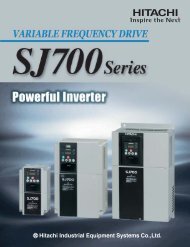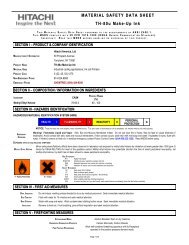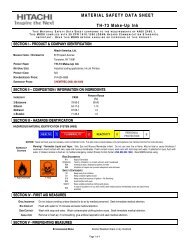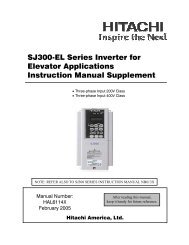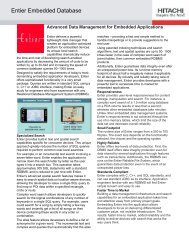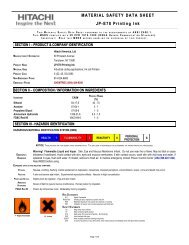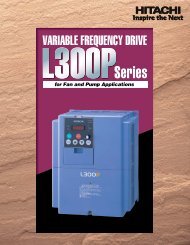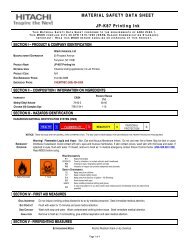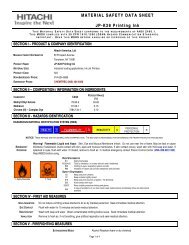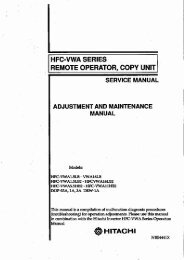Instruction Manual - Hitachi America, Ltd.
Instruction Manual - Hitachi America, Ltd.
Instruction Manual - Hitachi America, Ltd.
- No tags were found...
Create successful ePaper yourself
Turn your PDF publications into a flip-book with our unique Google optimized e-Paper software.
Cautions for UL and cUL(Standard to comply with : UL508C,CSA C22.2 No.14-05)Wiring diagram of inverterPowersupplyCircuit breaker orFuseRSTPDInverterPDC link chokeUVWMotora) Maximum surrounding air temperature rating of 50ºC.b) Solid State motor overload protection reacts with max. 150 % of FLA.c) Suitable for use on a circuit capable of delivering not more than 100,000 rms Symmetrical Amperes, 240 Volts Maximum.d) Drive has no provision for motor over temperature protection. Motor over temperature protection is required at end application.e) Protected by J, CC, G or T Class Fuses. or when protected by a circuit breaker having an interrupting rating not less than 100,000 rmssymmetrical amperes, 240 Volts maximum.f) Integral solid state short circuit protection does not provide branch circuit protection. Branch circuit protection must be provided in accordancewith the National Electrical Code and any additional local codes.g) Drive has no provision for motor over temperature protection. Motor over temperature protection required at end application.h) Use 60/75ºC CU wire only.i) Tightening torque and wire range as shown in the table below.Model No.Required Torque Wire Range(N.m)(AWG)NES1-002S 0.8~1.0 16~14NES1-004S 0.8~1.0 16~14NES1-007S 1.8 14~12NES1-015S 1.8 12~10NES1-022S 1.8 10NES1-002L 0.8~1.0 16~14NES1-004L 0.8~1.0 16~14NES1-007L 0.8~1.0 16~14NES1-015L 1.8 14NES1-022L 1.8 12j) Distribution fuse and circuit breaker size marking is included in the manual to indicate that the unit shall be connected with a Listed CartridgeNonrenewable fuse or Inverse time circuit breaker, rated 600 VAC with the current ratings as shown in the table below:Model No.NES1-002SNES1-004SNES1-007SNES1-015SNES1-022SNES1-002L*NES1-004L*NES1-007L*NES1-015LTypeClass J, CC,G or TClass J, CC,G or TFuseMaximumRating10 A20 ACircuit BreakerMaximumTypeRatingInverse Time15 A30 A 30 A10 A15 AInverse Time15 ANES1-022L 20 A 20 A* In case of using Circuit Breaker, an additional 5 A external protector is needed.3
2. Name of each portion (removed front cover)1 Connector for dedicatedoperator for NES1-OP2 RUN/STOP/RESET keys5 Switch for termination resistor SW4OFF(Default) P96 Switch for RS485/OPE SW5OPERS485(Default)→ P97 RS422/RS485 portON3 Intelligent relay terminal P8 to 94 Main terminal P8 to 98Switch for O/OI (analog input)changeover SW6Current OI P99 Logic terminal A9 Logic terminal B P8 to 9Voltage O(Default)10 Charge indicator lampNameDescription1 Connector for dedicated operator Dedicated operator for NE-S1 (NES1-OP) can be connected on this connector.for NES1-OP2 RUN/STOP/RESET key Push key for run, stop and reset operation.3 Intelligent relay terminal Output terminal for intelligent relay (1 from c contact).4 Main terminal For connecting power supply, motor output and DC reactor.5 Switch for termination resistor Switch for integrated termination resistor (100Ω) for RS485.Integrated resistor of 100Ω isconnected when switched ON.6 Switch for RS485/OPE Changeover switch for RS422/RS485 communication setting.7 RS422/RS485 port Connector for RS485 external operator or PC software (RJ45 jack)8 Switch for O/OI (analog input) Voltage input (O) or current input (OI) can be selected using this switch.changeover9 Logic terminal A,B Terminal for connecting input/output signals (digital/analog) for the inverter control.10 Charge lamp Turns ON when the internal DC bus voltage is 45V or more.In case of wiring, maintenance or else, please be sure to check that this lamp is turned OFFafter waiting 10 minutes of power OFF.Note1) Refer to page 13 for the description of the display and key operation.Note 2) Position of 10charge lamp depends on the model. Refer to page 11 for the details.Note 3) Pay attention when operating by PC via 7RS422/RS485 port, as the operation can also be done from the panel of the inverter.Note 4) Be sure to turn power OFF when connecting or disconnecting the operator such as OPE-SRmini,OPE-S,WOP to the 7RS422/RS485port.3. Cautions for installation1Caution during transportationPlease pay attention when carrying the product as it is covered by a plastic case.Especially, do not put pressure onto the front cover and terminal cover. Otherwise there is a risk of damaging the product.Please do not use products that are damaged, and/or lacking components.5
2Ensure Adequate VentilationTo summarize the caution messages – you will need to find a solid, non-flammable, vertical surface that is in a relatively clean and dry environment.In order to ensure enough room for air circulation around the inverter to aid in cooling, it is recommended to maintain the specified clearance andthe inverter specified in the below diagram.10 cm (3.94”)minimumAirflow5 cm (1.97”)minimum5 cm (1.97”)minimumSurface10 cm (3.94”)minimumAdequate space for the airflowmust be kept. Pay attention forwiring duct installation.3Caution for ambient temperatureVerify ambient temperature at installation site is within the standard specification range (-10~50°C). Measure ambient temperature 5cm fromthe bottom center of inverter main body and confirm that it is within the allowable temperature range.Using the inverter at higher temperature than allowable temperature may result in shortening of lifetime of inverter (especially of electrolyticcapacitors). A derating curve is shown on QRG (Please refer to the website.)4Do not install the inverter in such places as high temperature, high humidity, or prone to condensation.Use the inverter within the allowable humidity range (20~90%RH) described in standard specifications.Especially, please use it in place where no condensation occurs. If condensation occurs and beading is generated inside the inverter, electronicparts are short-circuited each other to cause a failure. Also, please avoid installing it in direct sunlight.5Caution for installation environmentPlease avoid installing the inverter in such places where dust, corrosive gas, explosive gas, flammable gas, mist of grinding fluid, or salt pollution,etc. exists.Invasion of dust, dirt etc. into the inverter may cause a failure. So, when you use it in dusty place by necessity, please devise a countermeasuresuch as putting it into a closed type chassis.CAUTION-Reduction of the carrier frequency or using bigger kW model is required if depends on the load or ambient.- Do not open the front cover during operation.WARNING6Cautions for installation direction¥Surface of the installation must be no vibration, and should be capable of holding the weight of the product. And the product must be fixed to thesurface with proper screws in a vertical direction. Be sure to screw using all the screw holes for the installation.(002L/SB,004L/SB,007LB : 2 positions, 007SB,015L/SB,022L/SB : 4 positions)There is a risk of performance failure, and/or breakdown when the product is not installed vertical direction.6
7Cautions for installation into the cabinetPlease pay attention to the location of the ventilation holes of the inverter and the cabinet, in case of side-by-side installation and using ventilationfan.cooling performance of the inverter highly depends on the location of the holes. Please pay high attention to the ambient temperature of theinverter to be less than the specified value.VentilationVentilationInverterInverter8Watt Loss(Good)(Bad)Position of the ventilation1-ph./3-ph. 200V classModel name 002S/L 004S/L 007S/L 015S/L 022S/LWatt Loss (100% load)(W) 22 30 48 79 104Efficiency at rated load(%) 90 93 94 95 95.54.1 How to attach and remove the front cover(1) How to remove1 Loosen up the screw2 remove the cover by pressing the bottom sideof the cover to the direction shown below.3 Move the wiring plate like shown belowin case of wiring.Press in this directionScrew for fixing the front cover is located at right-bottom sideWindow for connectingRS422/RS485Front coverScrew for fixingfront coverScrew for fixingfront cover(2) It is necessary to make window on the front cover when using remote operator (OPE-S/SR/SBK/SRmini, WOP), Modbus-RTU, or PC software(ProDriveNext). See above for the position of the window.- Be sure to make window after removing the front cover.- There are cutouts at the window, so it can be removed easily by pressing up side and bottom side of the window alternatively.- The window cannot be restored if it is once opened. Please use commercially supplied RJ45 connector cap or the like if necessary.(3) How to attach- Press the front cover to the main body until there is a click sound.- Do not tighten the screw too much.7
4.2 Wiring and terminal descriptionELBPower source,3-phase or1-phase, perinverter modelRefer to QRG (section 5.7) when usingexternal equipment for source logicoutput and/or external power supply.MCShort circuit barR/L1S/L2T/L3P24PLCL(L1)(N)DC24VLU/T1V/T2W/T3PD/+1P/+MMotorShort circuit barDCLRemove the jumperwire when using DCL(DC link choke)5Intelligent inputs,7 terminals4.7kΩ432AL0AL1AL2Relay contacts14.7kΩ1kΩ~2kΩDC10V(10mA Max.)HDC10V11Intelligent input terminal0-10VDC(10bit)O/OISW6OIApprox.250ΩOApprox.10kΩCM2Pulse train outputFMLLLLNote 1) Above shows an example of voltage (O) input. Changeover of SW6 must be done in case of current (OI) input. (Refer to page 9).(1) Mains terminal descriptionSymbol Name DescriptionR/L1(L1)S/L2T/L3(N)U/T1V/T2W/T3PD/+1P/+Power input terminalsPower output terminalsDC link choke connectionterminalConnect power supply- Use [L1] and [N] terminal in case of 1-ph. 200V power supplyConnect 3-ph. motorCategory D grounding (200V class)First, remove the short circuit bar between PD/+1 and P/+ terminal.Then connect optional DC link choke for improving the input harmonics.G( ) Earth terminalTo make grounding. Be sure to make this grounding to avoid electric shock, and for improvingthe EMC performance. The terminal is located on the heatsink.8
(2) Control terminal descriptionCategory Symbol Name Description Electrical characteristicsAnalogDigitalPowersupplyFreq.setPowersupplyLHO/OILP24PLCCommon for input signalsPower supply for externalpotentiometerAnalog voltage(Use SW6 for selection)Analog current(Use SW6 for selection)Common of digital and analogInputsPower supply for digital inputsPower supply terminalfor input terminalsCommon for internal control power supply, digitalinputs/outputs, analog inputs/outputsDC10V power supply. Used with variable resistor for Oinput.Frequency set via DC0~10V inputFrequency set via 0~20mAParameter adjustment should be done in case of 4~20mACommon for internal control power supply, digital inputs,analog inputs/outputsDC24V power supply for dry contact input. (Commonterminal in case of source logic)Sink logic : connected to P24Source logic : connected to LRemove the jumper wire when using external power supplyfor controlling the dry contact inputs (Refer to “QRG”5.7)Max.10mA withdrawInput impedance=apprx.10kΩAllowable range;-0.3~+12VDCInput impedance=apprx.250ΩAllowable range;0~24mAMax.100mA outputCategory Symbol Name Description Electrical characteristicsInputContact54321Intelligent inputterminalsSelect 5 functions from 35 available functions when can beassigned to any terminal 1 to 5. Sink or source logic canbe selected. Refer to section 7.3 of “QRG” for the detailsVoltage between each input and PLC- V(ON) = min.18V- V(OFF) = MAX.3V- Max. allowable voltage = 27VDC- Load current 5mA (24V)DigitalOutputOpen-collectorRelay11CM2AL0AL1AL2IntelligentoutputterminalsCommon forintelligent outputterminalsIntelligent relayoutputsOne function from 28 available functions can be assigned.Refer to section 7.3 of “QRG” for the detailsCommon for the terminal 11.One function from 28 available functions can be assigned.(1-c contact)Refer to section 7.3 of “QRG” for the details.Open collector outputBetween 11 and CM2- Voltage drop during ON=4V or less- Max. allowable voltage = 27V- Max allowable current = 50mAMax. allowable current = 100mAMax. contact capacityAL1-AL0 : AC250V,2A(resistive),0.2A(inductive)AL2-AL0 : AC250V,1A(resistive),0.2A(inductive)Min. contact capacityAC100V, 10mADC5V, 100mAPulsetrainFMDigital pulsetrain output(PTO) Pulse frequency maximum is 3.6kHzPulse voltage : DC0/10V outputMax. allowable current : 2mA(3) Changeover switch descriptionRefer to page 5 for the location of the switches.CAUTION- Adjustment of the switch must be done during power off. Otherwise there is a risk of electric shock.- Power ON must be done after closing the front cover. Do not open the front cover during power up, or when there is a remaining voltage.There is a risk of electric shock.Symbol Name DescriptionSW4SW5SW6Termination resistorselection switchRS485/OPE(RS422)selection switchAnalog input (O/OI)selection switchSelect able/disable of the termination resistor of RS485 port (RJ45)OFF (left side) Termination resistor (100Ω) Disable (Default)ON (right side) Termination resistor (100Ω) AbleSelect depending on the options and communication method, connected to RS422/RS485 port.OFF(right side) For operator (OPE-S/SR/SBK/SRmini),ProDriveNext (Default)ON(left side) For RS485 communication (Modbus-RTU)OFF (left side) Current input (0~20mA) OION (right side) Voltage input (0~10Vdc) O (Default)9
4.3 Mains wiring(1) Cautions on wiringBe sure to confirm that the charge lamp is turned OFF before the wiring work.Once it is powered up, there will be a remaining voltage at the DC bus capacitor for a certain period regardless the motor operation.Wiring work must be done 10 minutes after the power off, and after confirming the safety of personnel.In case the power indication of the operator does not turn ON after power-up, inverter may be damaged. In that case, the inspection must be doneafter waiting two hours or more of the power OFF. Otherwise there is a danger of electric shock and/or injury.1Mains input terminals (R/L1,S,T/N)・ Use earth leakage breaker (ELB) for protection between power supply and input terminals (R/L1,S,T/N).・ The ELB is recommended to have bigger capability for the high frequency sensitivity, so to avoid malfunction.Distance betweeninverter and motor100m or less300m or less800m or lessCutoff currentof ELB30mA100mA200mA・ There is a possibility that the malfunction or failure of the customer’s system when the protection circuit of the inverter is activated. Please usemagnetic contactor to shutoff the inverter power supply.・ Do not turn power ON and OFF by the magnet contactor at the primary side or secondary side of the inverter to start and stop the motor. Useoperation command (FW, RV) from the control input terminal in case of using external signal.・ Do not use the 3-ph input type with single phase input (phase loss). Otherwise there is a risk of inverter failure. Single phase input to the 3 phasetype inverter will result in a undervoltage, overcurrent, or will result in a damage of the inverter. [DC bus capacitor will be charged even underphase loss and it is dangerous. Refer to “(1) Cautions for wiring” for the wiring.]・ There is a risk of breakdown of the internal converter module, and/or shortening drastically the lifetime of DC bus capacitors due to an increaseof the ripple current. Especially, if high reliability is required on the system, use AC reactor between power supply and inverter. And if severeweather,such as thunderstorms is expected, use appropriate lightning protection equipment.- Unbalance at the input voltage (3% or more)- Impedance of the power supply is 10 times or more, and 500kVA or more- Rapid change is voltage is expected(Example)- 2 or more inverters are connected at the same net with short cable.- Inverter is connected in parallel with the thyristor equipment with short cable.- Phase advancing capacitor is switching on a same net・ Frequency of the power ON/OFF must be once/3 minutes or longer interval. There is a danger of inverter failure.・ An inverter run by a private power generator may overheat the generator or suffer from a deformed output voltage waveform of thegenerator. Generally, the generator capacity should be five times that of the inverter (kVA) in a PWM control system or six times greaterin a PAM control system.・ In the case of important equipment, to shorten the non-operational time of inverter failure, please provide a backup circuit by commercial powersupply or spare inverter.[Rough indication of earth leakage current] 30mA/km : use CV cable with metallic tube. Leakagecurrent will be approximately 8 times more when using H-IV cable.Therefore, it is recommended to use one class bigger capability of the ELB. Previously mentioned“leakage current” is based on the RMS value of fundamental wave, excluding harmonic current.・ In case of commercial power source switching functionality,mechanical interlock the MC1 & MC2 contacts with each others is required.Otherwiseyou may damage the inverter and the danger of injury and/or fire.Please refer to following diagram.MC1ELBPowersourceMC0R/L1 US Inveter VT/NWMC2Motor2Inverter output terminals (U, V, and W)・ Use larger gauge cable leads than the specified applicable cable for the wiring of output terminals to prevent the output voltage drop between theinverter and motor. Especially at low frequency output, a voltage drop due to cable resistance will cause the motor torque to decrease.・ Do not connect a phase-advanced capacitor or surge absorber on the output side of the inverter. If connected, the inverter may trip or thephase-advanced capacitor or surge absorber may be damaged.・ If the cable length between the inverter and motor exceeds 20 m (especially in the case of 400 V class models), the stray capacitance andinductance of the cable may cause a surge voltage at motor terminals, resulting in a motor burnout. A special filter to suppress the surge voltageis available. If you need this filter, contact your supplier or local <strong>Hitachi</strong> Distributor.・ When connecting multiple motors to the inverter, connect a thermal relay to the inverter output circuit for each motor.・ The RC rating of the thermal relay must be 1.1 times as high as the rated current of the motor. The thermal relay may go off too early, dependingon the cable length. If this occurs, connect an AC reactor to the output of the inverter.3DC reactor connection terminals (PD and P)・ Use these terminals to connect the optional DC power factor reactor (DCL).As the factory setting, terminals P and PD are connected by a jumper. Remove this to connect the DCL.・ The cable length between the inverter and DCL must be 5 m or less.Remove the jumper only when connecting the DCL.If the jumper is removed and the DCL is not connected, power is not supplied to the main circuit of the inverter, and theinverter will not operate.10
4Inverter ground terminal (G )・ Be sure to ground the inverter and motor to prevent electric shock.・ According to the Electric Apparatus Engineering Regulations, connect 200 V class models to grounding electrodes constructed in compliancewith type-D grounding (conventional type-III grounding with ground resistance of 100Ω or less) or the 400 V class models to grounding electrodesconstructed in compliance with type-C grounding (conventional special type-III grounding with ground resistance of 10Ω or less).・ Use a grounding cable thicker than the specified applicable cable, and make the ground wiring as short as possible.・ When grounding multiple inverters, avoid a multi-drop connection of the grounding route and formation of a ground loop, otherwise the invertermay malfunction.InverterInverterInverterInverterInverterInverterGrounding boltprepared by user(2) Layout of main circuit terminalsThe figures below show the terminal layout on the main circuit terminal block of the inverter.The main circuit terminal block opens a faceplate and wires it.Single-phase 200V 0.2 to 0.4kWThree-phase 200V 0.2 to 0.75kWSingle-phase 200V 0.75 to 2.2kWThree-phase 200V 1.5, 2.2kWSingle-phasetypeL1 N P/+Single-phase typeU/T1V/T2W/T3PD/+1Charge lumpL1 N PD/+1 P/+ U/T1 V/T2 W/T3Three-phasetypeR/L1 S/L2 T/L3 P/+Three-phase typeCharge lumpU/T1V/T2W/T3PD/+1R/L1S/L2T/L3PD/+1P/+U/T1V/T2W/T3From source(4)Wiring and AccesoriesThe table below lists the specifications of cables, crimp terminals, and terminal screw tightening torques for reference.Wiring Accessories Note1)ApplicableSize of terminalMotorGauge of power lineMagneticFuseInputinverteroutputVoltagemodelcable (mm 2 screw)Tightening Earth-leakagecontactorTerminal width(UL-rated,(kW)torque breaker (ELB)NES1- Note3)(mm)(MC)(N-m) Note2)Note5)class J,600V)Note4)Note2) Note6)1-phase200V3-phase200VTo motorFrom sourceTo motor0.2 002SB AWG14 (2.0) M3.5 (7.6) 1.0 EX30 (5A) H10C 10A0.4 004SB AWG14 (2.0) M3.5 (7.6) 1.0 EX30 (10A) H10C 10A0.75 007SB AWG14 (2.0) M4 (10) 1.4 EX30 (15A) H10C 15A1.5 015SB AWG10 (5.5) M4 (10) 1.4 EX30 (20A) H20 20A2.2 022SB AWG10 (5.5) M4 (10) 1.4 EX30 (20A) H20 30A0.2 002LB AWG16 (1.25) M3.5 (7.6) 1.0 EX30 (5A) H10C 10A0.4 004LB AWG16 (1.25) M3.5 (7.6) 1.0 EX30 (10A) H10C 10A0.75 007LB AWG16 (1.25) M3.5 (7.6) 1.0 EX30 (10A) H10C 15A1.5 015LB AWG14 (2.0) M4 (10) 1.4 EX30 (15A) H10C 15A2.2 022LB AWG14 (2.0) M4 (10) 1.4 EX30 (20A) H20 20ANote 1)The peripheral equipment described here is applicable when the inverter connects a standard <strong>Hitachi</strong> 3-phase, 4-pole squirrel-cage motor.Note 2)Select breakers that have proper capacity. (Use breakers that comply with inverters.) Select above proper ELB capacity following above tablefor the 1pc inverter. Only 1 inverter must be supplied by the above proper ELB.Note 3)If the power line exceeds 20m, cable that is thicker than the specified applicable cable must be used for the power line.Note 4)Use copper electric wire (HIV cable) of which the maximum allowable temperature of the insulation is 75°C.Note 5)Use earth-leakage breakers (ELB) to ensure safety.Note 6)To comply UL, use either ELB/or FUSE which is specified by UL for the Power supply for the inverter.Note 7)The ground or earthed line should be a larger gauge than electric supply wire diameter used in the power line.11
5.1 Confirmation before power up the inverterPlease confirm the followings before operation.(1) Connection of the power input (R,S,T, L1,N) and motor (U/T1, V/T2, W/T3) is correctly connected. Otherwise there is a risk of inverter failure.(2) There must be no incorrect-connection of the control wiring. Otherwise there is a risk of inverter failure.(3) Earth grounding is properly connected. Otherwise there is a risk of electric shock.(4) There is no ground fault other than earth grounding terminal. Otherwise there is a risk of inverter failure.(5) There must be no short circuit such as wire strands or chips etc., there must be no tools left inside the inverter. Otherwise there is a risk ofinverter failure.(6) There must be no short circuit or ground fault at the output side. Otherwise there is a risk of inverter failure.(7) Front cover must be closed. Otherwise there is a risk of inverter failure.5.2 Changing parametersOne of the following is required when changing parameters on NE-S1 series inverters.(1) Dedicated operator (NES1-OP)The operator (NES1-OP) is used with integration onto the inverter. It is not possible to use the operator external with cable.(2) Digital operator (OPE-SRmini,OPE-S/SR/SBK)Digital operator can be used with connector cable (ICS-1,3) and connected to the RS422/RS485 port (RJ45) in the inverter. Turn thechangeover switch to the operator side (OFF side) in that case (See page 9). Refer to the manual for each operator for the detailed information.(3) 5-line LCD operator (WOP)WOP having serial number of “16918938000081” or later (2011/07 production) is applied to NE-S1 series inverter. (English only)WOP can be used with connector cable (ICS-1,3) and connected to the RS422/RS485 port (RJ45) in the inverter. Turn the changeover switchto the operator side (OFF side) in that case (See page 9). Refer to the manual for WOP for the detailed information.(4) PC programming tool (ProDriveNext)ProDriveNext Version “1.2.33.000” and later is applied to the NE-S1 series inverter.PC can be used with connector cable (ICS-1,3) and connected to the RS422/RS485 port (RJ45) in the inverter. Turn the selection switch to theoperator side (OFF side) in that case (See page 9). Refer to the manual for ProDriveNext for the detailed information.NOTE: It is necessary to turn power off to store the changed data.5.3 Power up the inverter(1) Power up the inverter after confirming the items shown in above section 5.1.(2) Confirm the LED is emitting like shown below.- Standard panel : Confirm that both PWR lamp and Key valid lamp are emitting- Dedicated operator (NES1-OP) : Confirm that the PWR lamp is emitting. Display will be the one set by b038 (Initial display selection).“0.00(output frequency monitor)” will be displayed under default condition.(3) Refer to section “5.4 Operating the inverter” and set required parameters. And then refer to section “5.5 Motor operation”.Standard panelNote 1) It will take around 1.5 seconds for the inverter to be ready(each LED emits). Please take in account this delay in case of an application ,for which this delay will be important.12
5.4 Names and functions of componentsStandard panel4Key valid lamp1POWER LED2Run command LED3ALARM LED6RS422/RS485 port (RJ45)5RUN/STOP/RESET keyNameDescription1POWER LED- Turns on (red) during inverter is powered up2Run command LED- Turns on (green) during inverter operation. (This turns ON either Run command is given, or the inverter is givingout power. Therefore it keeps turning on during 0 Hz driving, or keeps turning on during deceleration period evenafter the run command is OFF.3ALARM LED- Turns on (red) when the inverter is in trip status.- Refer to section 6.8 of QRG how to reset the trip status.4Key valid lamp5RUN/STOP/RESET key6RS422/RS485 port (RJ45)- Turns on (green) when the RUN/STOP/RESET is ready. It turns off when there is a RUN command. If the runcommand is being given from the RUN/STOP/RESET key, the lamp is being on during deceleration period evenafter the run command is OFF. While Run command is given such as FW(RV) terminal,if "RUN/STOP/RESET key"was pressed, even Run command is OFF, the "Key valid lamp" is OFF until inverter is Stopped.- Makes inverter run, stop and reset. RUN/STOP/RESET key is set default and it can be made invalid by the keysensitivity selection (C151) to “no”.- It restores from the trip state if the inverter is in trip state.- If the ModBus communication is selected, it can be temporary changed to an external operator mode if the inverteris powered up with pressing the RUN/STOP/RESET key and keep it pressing 5seconds,and take off from thekey.. Changeover switch must be changed later on. Note 1)- This is a port for external operator, Modbus connection, or ProDrioveNext (RS485/operator changeover switchmust be operated) before Power ON. In case of Modbus communication, it is necessary to set the changeoverswitch and parameter (C070). Display of NES1-OP will be according to the parameter set of b150 continuously, ifthe external operator is connected while the dedicated operator (NES1-OP) is integrated. Note2)Note 1) It is necessary to set changeover switch and the parameter C070 for releasing the Modbus communication. If the parameter C070 isset to ModBus, external operator via the RS45 jack cannot be used.Note 2) Connecting to the RJ45 jack must be done during the inverter power off.5.5 Motor operationBoth “Run command” and “frequency command” is necessary to run the motor. Motor does not run if one of each is missing. For example, motor willnot run when a run command is given, but a frequency command is 0Hz. Additionally, the motor will not run if a FRS (free run stop) signal (and the like)is being given.NE-S1 series inverter has following way to set the run command and frequency command. (This is an example of sink logic and uses internalcontrol power supply.)Driving method in the default:5.5.1→13
5.5.1 Driving with the standard panelRUN/STOP/RESET key on the standard operation panel is effective regardless of the setting of the driving order method(A002). Thus, the followingoperation method (1) to (3) is possible without an option if it is an initial value.(1)Method to perform driving in RUN/STOP/RESET key and perform frequency setting in Multispeed selectThis is the operation method using Run command is given by "RUN/STOP/RESET key"& Frequency setting is given by Fixed value such as 20/40/60Hz, Accel&Decel time is10 seconds. If you don't need to change parameters such as Accel&Decel time, theoptional Operator is not required.) To use the set Freq. setting, use the Multi-speeddefault frequency setting (1=60Hz),(2=40Hz),(3=20Hz).■Control circuit terminals wiring4 3 … LPLCP24■SetupFunction Name Code Data NoteInput [3] function C003 02(CF1)Input [4] function C004 03(CF2)DefaultThe initial value of Acceleration/ Deceleration time is 10sec.Please change the following parameters as needed.Function Name Code Setting Range NoteAcceleration time F002 0.00 to 3600sec. Default:10 sec.Deceleration time F003 0.00 to 3600sec. Default:10 sec.※ One of the following is required when changing parameters on NE-S1 series inverters.1 Dedicated operator (NES1-OP) 2 Digital operator 3 5-line LCD operator4 Modbus 5 PC programming tool (ProDriveNext)(2) Method to perform driving in RUN/STOP/RESET key and perform frequency setting in speed potentiometerThis is the operation method using Run command is given by "RUN/STOP/RESET key" & Frequency setting is given by analog input such asO-L voltage, Accel&Decel time is 10 seconds. If you don't need to change parameter such as Accel&Decel time, the optional Operator is not required.)Below diagram is to set the external Freq. setting connecting H-O-L volume to supply O-L voltage.■SetupFunction Name Code Data NoteFrequency source A001 01(Control circuit terminals) DefaultThe initial value of Acceleration/ Deceleration time is 10sec.Please change the following parameters as needed.Function Name Code Setting Range NoteAcceleration time F002 0.00 to 3600 sec. default:10 sec.Deceleration time F003 0.00 to 3600 sec. default:10 sec.※ One of the following is required when changing default parameters on NE-S1 seriesinverters.2 Dedicated operator (NES1-OP) 2 Digital operator 3 5-line LCD operator4 Modbus 5 PC programming tool (ProDriveNext)(3) Method to perform driving in FW/RV teraminal and perform frequency setting in volume resistorThis is the operation method using Run command is given by intelligent input terminal such as FW(RV) function & Frequency setting is given byanalog input such as O-L voltage. If you don't need to change such as Accel&Decel time, optional Operator is not required.) Below diagram is to setthe external Freq. setting connecting H-O-L volume to supply O-L voltage.CF2CF1■Example of use(default)Intelligent inputterminal [3]Intelligent inputterminal [4]60Hz order OFF ON40Hz order ON OFF20Hz order ON ON■Control circuit terminals wiringHO/OIFrequency settingresistorLPLCP24Note)The above is a method to perform analoginput(O/OI) by voltage input. It is necessary forSW6 on the board to be set for voltageinput(default). →P9■SetupFunction Name Code Data NoteFrequency source A001 01(Control circuit terminals) DefaultRun command source A002 01(Control circuit terminals) DefaultInput [1] function C001 00(FW)Input [2] function C002 01(RV)The initial value of Acceleration/ Deceleration time is 10sec.Please change the following parameters as needed.Function Name Code Setting Range NoteAcceleration time F002 0.00 to 3600 sec. Default:10 sec.DefaultDeceleration time F003 0.00 to 3600 sec. Default:10 sec.※ One of the following is required when changing default parameters on NE-S1 seriesinverters.1 Dedicated operator (NES1-OP) 2 Digital operator 3 5-line LCD operator4 Modbus 5 PC programming tool (ProDriveNext)■Control circuit terminals wiringHO/OILFrequency settingresistor2RVPLCNote)The above is a method to perform analoginput(O/OI) by voltage input. It is necessary forSW6 on the board to be set for voltageinput(default). →P91FWLP2414
6.1 SpecificationsItem Three-phase 200V class Specifications Single-phase 200V class SpecificationsWJ200 inverters, 200V models 002L 004L 007L 015L 022L 002S 004S 007S 015S 022SApplicable motor sizeNote1)Rated capacity(kVA)Rated input voltagekW 0.2 0.4 0.75 1.5 2.2 0.2 0.4 0.75 1.5 2.2HP 1/4 1/2 1 2 3 1/4 1/2 1 2 3200V 0.4 0.9 1.3 2.4 3.4 0.4 0.9 1.3 2.4 3.4240V 0.5 1.0 1.6 2.9 4.1 0.5 1.0 1.6 2.9 4.1Three-phase: 200V-15% to 240V +10%, 50/60Hz±5%Rated output voltage Note2) 3-phase: 200 to 240V (proportional to input voltage)Single-phase: 200V-15% to 240V +10%, 50/60Hz ±5%Rated output current (A) 1.4 2.6 4.0 7.1 10.0 1.4 2.6 4.0 7.1 10.0Cooling method Self-cooling Force ventilation Self-cooling Force ventilationBraking(capacitive feedback)WeightNote3)Common specificationApprox.50% Approx.20 to 40% Approx.50% Approx.20 to 40%(kg) 0.7 0.8 0.9 1.2 1.3 0.7 0.8 0.9 1.2 1.3(lb) 1.6 1.8 2.0 2.7 2.9 1.6 1.8 2.0 2.7 2.9項 目 仕 様Protective housing(JIS C 0920,IEC60529)IP20ControlInput signalOutputsignalControl methodOutput frequency range Note4)Frequency accuracyNote5)Frequency setting resolutionVolt./Freq. characteristicOverload capacityAcceleration/deceleration timeFreq. settingRUN/STOP OrderIntelligent input terminalAnalog inputIntelligent output terminalPulse OutputSinusoidal Pulse Width Modulation (PWM) control0.1 to 400 HzDigital command: ±0.01% of the maximum frequencyAnalog command: ±0.2% of the maximum frequency (25°C ± 10°C)Digital input: 0.01 HzAnalog input: Maximum output frequency/1000V/f control (constant torque, variable torque)150%/60 seconds0.01 to 3,600.0 seconds (in linear or curved pattern)、2nd motors setting is possibleExternal signal:adjustable resistor / 0 to +10 VDC /0 to 20 mA,Modbus、Option operator、Dedicated operatorExternal digital input signal(3-wire input possible), ModbusOption Operator、Dedicated Operator5terminals1terminal( O/OI terminal:Voltage input10bit/0 to 10V, Current input:10bit/0 to 20mA selected with aselection switch)5 open-collector output terminals, 1 relay (1 from c-contact) output terminal1terminalconnectionRS-422RS-485RJ45 Connector ,(Common with RS485:selecting it with a selection switch)Option Operator,ProDriveNextRJ45 Connector ,( Common with RS422:selecting it with a changeover switch)Modbus-RTUTemperature Note6) Operating (ambient): -10 to 50°C, / Storage: -20 to 65°CGeneralspecificationNote1)Note2)Note3)Note4)Note5)Note6)HumidityVibrationLocationStandards Compliance20 to 90% humidity (non-condensing)5.9m/s 2 (0.6G), 10 to 55 HzAltitude 1,000m or less, indoors (no corrosive gasses or dust)UL、CE、c-UL、c-tickThe applicable motor refers to <strong>Hitachi</strong> standard 3-phase motor (4p). When using other motors, care must be taken to prevent the ratedmotor current (50/60Hz) from exceeding the rated output current of the inverter.The output voltage decreases as the main supply voltage decreases (except when using the AVR function). In any case, the output voltagecannot exceed the input power supply voltage.The braking torque via capacitive feedback is the average deceleration torque at the shortest deceleration (stopping from 50/60Hz asindicated). It is not continuous regenerative braking torque. The average deceleration torque varies with motor loss. This value decreaseswhen operating beyond 50Hz.To operate the motor beyond 50/60Hz, consult the motor manufacturer for the maximum allowable rotation speed.To get motor stabilized operation, inverter output Frequency might exceeds preset maximum Freq.(A004/A204) by 2Hz in maximum.Derating curve is shown on QRG (Refer to section 12.3 of QRG).15
6.2 DimensionsModelW(mm)H(mm)D(mm)D1(mm)NES1-002SB76 7NES1-004SB 91 21.5NES1-002LB 68 128 76 7NES1-004LB 91 21.5NES1-007LB 115 46ModelW(mm)H(mm)D(mm)NES1-015SB107NES1-022SB 125108 128NES1-015LB 107NES1-022LB 125ModelW(mm)H(mm)D(mm)NES1-007SB 108 128 96SUITABILITY FOR USE<strong>Hitachi</strong> Industrial Equipment Systems shall not be responsible forconformity with any standard, codes, or regulations that apply to thecombination of products in the customer’s application or use of theproducts.Take all necessary steps to determine the suitability of the product for theSystems, machines, and equipment with which it will be used.Please know and observe all prohibitions of use applicable to theproducts.NEVER USE THE PRODUCTS FOR AN APPLICATION INVOLVINGSERIOUSRISK TO LIFE OR PROPERTY WITHOUT ENSURING THAT THESYSTEMAS A WHOLE HAS BEEN DESIGNED TO ADDRESS THE RISKS, ANDTHATTHE HITACHI INDUSTRIAL EQUIPMENT SYSTEMS PRODUCTS AREPROPERLY RATED AND INSTALLED FOR THE INTENDED USEWITHIN THE OVERALL EQUIPMENT OR SYSTEM.See also product catalogs16



